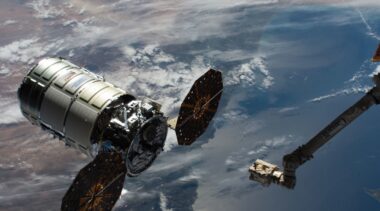Far too often, we take the ISS partnership for granted, when in fact it represents an unprecedented international collaboration that has proved that global human spaceflight cooperation is both possible and beneficial.

Moreover, for the past two decades, the ISS has proverbially and literally been an outpost on the frontier of science. More than 3,000 experiments have been conducted on the ISS in a diverse array of fields ranging from fundamental physics and Earth observation to biomedical studies and advanced manufacturing demonstrations.
Not only has the ISS supported unique science, the station has also been a singular source of soft power for the United States. America has served as the heart and glue for the station’s international coalition, enabling the U.S. to maintain its role as the world’s preeminent spacefaring nation.
However, in the harsh environment of space, nothing is permanent. Ideally, the ISS could serve as a platform for innovation for another decade and NASA should leverage every bit of utility it can get out of the station for as long as it can. Unfortunately, the ISS will inevitably need to be retired, and it is incumbent upon NASA and the entire American space community to avoid a space station gap.
This has happened before, with America losing the ability to launch astronauts into space and depending exclusively on Russia for crewed transportation for nearly a decade. This capability gap represented a holistic failure of planning and foresight that, thanks to public-private partnerships and commercial space capabilities, the nation is now starting to recover from. Yet, despite having only recently overcome a human space launch gap, the U.S. is already facing a space station gap that could be more pernicious than any other challenge that NASA has faced in the modern era.
THE PRICE OF INACTION
If the space industry and relevant policymakers fail to take robust action quickly, the U.S. will experience a crippling and lengthy space station gap. At a time when scientists are only beginning to understand the importance of microgravity research, development and manufacturing, the U.S. will lose access to low Earth orbit (LEO) and all the scientific benefits this unique environment has to offer. Additionally, America’s ability to train astronauts and prepare for long-duration missions to the moon and Mars will be lost, and NASA’s astronaut corps will shrink to a fraction of its current size.
Moreover, a space station gap will result in ceding both LEO and global leadership to China.
In April, China launched the first element of its new 66 metric ton three-module space station. China has learned from our experience with the ISS and is replicating both the capabilities of the station as well as the diplomatic and geopolitical benefits that a crewed LEO platform offers. During the next two years, China will conduct a flurry of activities to build this next-generation orbital outpost. Unless plans for an American commercial space station are executed with alacrity, this Chinese station will soon become the only crewed platform in LEO. In addition to ceding the benefits of microgravity research, development and manufacturing, as well as astronaut training to China, the U.S. will lose its role as the global leader in human spaceflight.
Space has always been closely intertwined with global politics. The Apollo era competition to land humans on the moon of course serves as the primary example of this, but the ISS’s role in geopolitics potentially rivals even that of Apollo. Over the past two decades, the ISS has served as a beacon of global cooperation supporting experiments from more than 100 nations and astronauts from 18. The ISS has deepened existing relationships with longtime American allies while broadening U.S. outreach to countries that are new to human spaceflight. Additionally, under the auspices of American leadership, ISS operations, including launch activities, have been both transparent and safe.
If the U.S. cedes LEO to China, we will abandon not only science and astronautics, but also our values, leaving China to set the agenda for humanity’s future in space. China will become the new global leader in astronautics and will enjoy the nontrivial political and diplomatic benefits that such a position brings. By becoming the only nation with a crewed platform in LEO, China will demonstrate, in both perception and reality, that its technologies and organizational capabilities are superior to the U.S. in this vital arena.
China already weaves space into its overall geopolitical strategy, including satellites and astronaut seats in its trade agreements and treaties. China also wisely leverages space in its relationship with the United Nations and has already selected payloads that will be flown on its space station from a variety of developing countries. A U.S. space station gap wherein China has the only crewed platform in orbit will further a narrative of American decline in the face of Chinese preeminence, the results of which will harm our nation’s global soft power and the perception of the U.S. and the values it stands for.

Lastly, it’s important to note the devastating effect a space station gap will have on the American space launch industry. America has spent billions of dollars developing new cargo and crew systems. These programs have energized the U.S. space launch industrial base and spurred innovations that have allowed America to recapture the commercial space launch market, which had previously been lost to overseas competition. Without a space station, demand for launch services will drop dramatically, jeopardizing not only American capabilities and science in LEO, but also U.S. launch capabilities and competitiveness. The negative effects of the loss of crewed LEO operations will thereby be felt far beyond NASA and will inevitably become a nontrivial threat to national security as well.
The overwhelming cost to the U.S. of a space station gap could not be more clear. Fortunately, the solution is equally apparent. Public-private partnerships and the rise of commercial space is transforming the space world.
Due in no small part to innovative leadership by NASA through initiatives such as the Commercial Orbital Transportation Services (COTS) program and the Commercial Resupply Services (CRS) contracts, the private sector has been able to deliver cargo and crew to LEO.
COMMERCIAL LEO DESTINATIONS
The obvious next step is for commercial firms to provide NASA with not just transportation, but a platform in LEO. A commercial space station could deliver all the benefits generated by the ISS along with renewed global outreach, enhanced affordability and continued scientific innovations. However, even with the private sector’s efficiencies, designing, developing and deploying a commercial space station will require substantial time and resources.
The private sector can meet this challenge, but it cannot do so alone. As in the COTS and CRS programs, NASA has a critical role to play. Specifically, NASA must serve as a catalyst and customer for the new commercial station. The agency must do all that it can to help stimulate demand for microgravity services. This means supporting projects on the ISS now that demonstrate how the microgravity environment can be used to manufacture new substances, produce advanced technologies and develop cutting-edge medical treatments that could transform a variety of fields here on Earth.
NASA should focus its support on activities with the greatest near-term potential to generate revenue that could help pay for the costs of a future commercial space station.
Unfortunately, although important to both space station operations and American competitiveness, profitable on-orbit manufacturing is unlikely to develop in the near future. Therefore, NASA has an immediate and vital role to play as a sophisticated customer for a commercial space station, and the agency’s Commercial LEO Destinations (CLD) project is a step in the right direction.
Over its 60-year history, NASA has been a trailblazer, not just in exploration, but also in technology investment and procurement methodology. Other Transaction Authority, which led to the rise and dominance of the American commercial space industry, was first utilized at NASA through Space Act Agreements (SAAs). SAAs were used for COTS, which garnered substantial private sector investment. Through COTS and other public-private partnerships such as the Bigelow Expandable Activity Module, NASA has expertly utilized its power as a customer to encourage outside investment. NASA purchasing systems and hardware sends a strong signal to investors and entrepreneurs who subsequently follow the agency’s lead.
In regard to private sector capabilities, buoyed by private equity, SPACs and venture capital generally, the commercial space field has never enjoyed greater financial wherewithal. NASA would be wise to leverage this unprecedented period to further evolve the commercial space paradigm. Under COTS and CRS, the government paid for the private sector to develop services that the government then purchased. This model was wildly successful and saved the taxpayer billions of dollars. For activities that are within the reach of the private sector, NASA has and should continue to enter into public-private partnerships, allowing the agency to focus its resources on the frontiers of exploration and technology.
Despite past success, the existing commercial space paradigm must continue to evolve, and the next step is for the government to serve primarily as a customer. The private sector has the desire and ability to fund the development and deployment of a commercial space station.
However, for companies to access sufficient capital to field a commercial space station, NASA must lean forward as much as it can to reassure industry that it will be a robust and ongoing customer. NASA’s desire to continuously fly two crew members in LEO and perform 200 investigations per year is a good start. If NASA can incorporate such a commitment into the initial CLD SAAs and potentially include additional crew and investigations in the future, such actions will position the private sector for success.
Change is inevitable, but it is also beneficial and necessary for institutions, ideas and even individuals to survive and thrive. The environment in LEO is changing and American capabilities must also change to meet tomorrow’s challenges. China is wisely investing in crewed LEO operations and making strong diplomatic overtures to build a global coalition for its space program. To avoid ceding LEO to China, the U.S. must lean into its traditional strengths, specifically, entrepreneurialism and innovation, both of which are driven by the freedom and diversity that are the twin pillars of American society.
Taking the concept of a commercial space station from idea to reality will require a concerted effort from all of us. NASA, Congress, the executive branch and industry must all work quickly and in unison. Together, we can build a bridge that will allow America to safely and successfully cross over the space station gap, on a path toward a future of peace and prosperity in LEO and beyond for the U.S. and all of humanity to enjoy.
Mike Gold is Redwire’s Executive Vice President of Civil Space Business Development and External Affairs.
This article originally appeared in the June 2021 issue of SpaceNews magazine.



